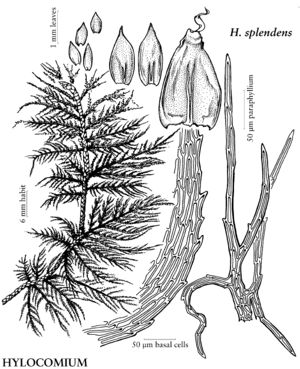Hylocomium
in P. Bruch and W. P. Schimper, Bryol. Europ. 5: 169, plates 487 – 493. 1852.
| Taxon | Illustrator ⠉ | |
|---|---|---|
 | Hylocomium splendens | Patricia M. Eckel |
Stems creeping to more often arching-ascending, 1–3 mm wide across leafy stem, sympodial, rarely appearing monopodial in reduced arctic-alpine forms, regularly 2-pinnate or 3-pinnate; paraphyllia many, base multiseriate, branches 1-seriate or 2-seriate. Stem-leaves tightly appressed on stipe to erect among branches, heteromallous, not crowded, oblong-ovate to ovate, lightly plicate, sometimes rugose in acumen, 1.6–3.2 (–4) mm; base not decurrent; margins serrulate to nearly entire proximally, serrate to serrulate distally; apex abruptly acuminate, or occasionally rounded, obtuse, or abruptly acute; costa double, 1/4–1/2 leaf length, sometimes nearly ecostate; alar cells not differentiated; laminal cells occasionally minutely prorate. Branch leaves ovate to elliptic-lanceolate. Capsule inclined to pendent; operculum conic, obliquely long-rostrate; exostome teeth reticulate proximally; endostome segments broadly perforate, usually split into one large gaping perforation.
Distribution
North America, Eurasia, n Africa, Pacific Islands (New Zealand), Australia, cool temperate, boreal, and arctic regions
Discussion
Species 1.
Selected References
None.
Lower Taxa
"nearly" is not a number. "single" is not a number."broad" is not a number.